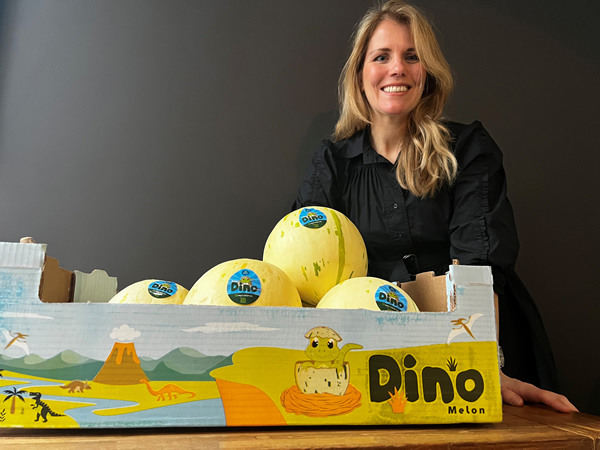Five years ago Total Produce introduced the DINO melon to the European market. This was, originally, an Asian variety, which is completely different from the other available melon varieties offered in the supermarkets. "We are regularly asked by retailers if there are any innovations within the category and often there are, but not always this visibly. The shelf life and the brix and aroma levels of the existing varieties are constantly being adjusted, for example. So the introduction of the DINO melon was really 'something different," says Saskia Polak.
"The interest of various retailers was aroused and we started with a number of chains. Initially, consumer response was cautious, but we soon realised that the concept appealed to consumers and that they were buying the melon again because of its flavour. It is deliciously sweet with a slightly softer flesh than other varieties," says Saskia.
"In the meantime, several years have passed and the number of retailers that have included DINO in their assortment has increased significantly. Especially in Scandinavia, Germany and Eastern Europe, the melon is highly appreciated by customers. We have also adapted the cultivation to the retail demands, so we produce slightly smaller melons compared to at the start, so that the unit price is not extremely high compared to the other melons."

Saskia Polak with the DINO melon
Pre-cut or loose
The Rotterdam fruit importer also sees great opportunities for the DINO within the convenience segment. "However, at the moment by far the largest proportion goes straight to the supermarket. The DINO would certainly be appreciated by consumers as a replacement for the yellow (YHD) melon in fruit salads, but the cost price is higher, which is why the DINO is less likely to be considered for processing. We have, however, developed a concept that can both support the loose sales and the ready-to-eat. The label with the DINO sticking its head out of the DINO egg can also be added to the seal of a ready-to-eat pack, giving the consumer the choice of buying the DINO pre-cut or loose. This line will be offered more widely next season to retailers who are interested in it."
Total Produce currently sources the DINO melon from Brazil and Spain. "In other production areas we are doing tests to grow a comparable DINO, but it is not an easy melon to produce, so the conditions have to meet a number of criteria to achieve a good end product," says Saskia. "One of the things we have done in recent years is to grow a smaller melon. They have adapted the cultivation technique and are also doing tests on different soil types. In Brazil, this melon is produced in a larger size range than in Spain, so each production area has to find their own way in producing the right size in the best possible way. The most common packaging at the moment is the 10kg carton, size 6. Retailers who sell by the piece can do well with this. All larger sizes are packed in 15kg cartons and these are sold to retailers who sell by the kilo."
More than just a children's friend
When asked if retailers would be open to introducing a kids concept, Saskia replies: "The DINO and its label certainly appeal to the imagination of children. The melon is deliciously sweet and will therefore go down well with most children. However, we see this melon as a family friend rather than just a child's friend. When it comes to kids concepts, people often think of small melons and concepts that involve a lot more packaging (e.g. three small melons packed together). However, this is not really the direction we want to go in. In any case, we reduce our packaging as much as possible and the product must be able to 'sell' itself. In addition, melons smaller than 1kg are quickly perceived as 'expensive' by consumers. So it's great that this melon appeals to children, but they are not the only target group for this product."
And does the purchase of the DINO melons come at the expense of the other melons or, on balance, result in higher melon sales? "At Total Produce, we see modest growth in the sales of our melon range every year. We also see that some of the retailers are interested in replacing the 'mid-pricers' in due course. For YHD and average Cantaloupe, some are looking for premium varieties that are partly available, think of the Charantais types of Cantaloupe and partly in development with regard to new types of YHD. In any case, we hope to be able to surprise again in the coming years with new varieties or hybrids that will appeal to the consumer and boost melon sales. It would be great if the consumer could vary and buy the melon he or she wants at that moment, both in summer and winter", concludes Saskia.
For more information:
Saskia Polak 
Total Produce B.V.
Port City 1
Waalhaven Zuidzijde 21
3038 JH Rotterdam
spolak@totalproduce.nl
www.totalproduce.nl
